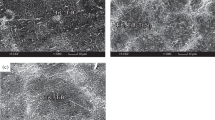The interaction of a Ti + 10 Mo titanium alloy, which serves as a matrix in a tribological material, with calcium fluoride CaF2 and boron nitride BN, which play the role of a solid lubricant, during their heating and sintering in a vacuum of 10–3 Pa at 1150°C for 15 and 120 min, respectively, has been studied. In the heating of a Ti + 10 Mo + CaF2 model sample for 15 min and sintering of Ti + 10 Mo + CaF2 CAM1 for 120 min, calcium fluoride does not interact with the Ti + 10 Mo matrix and does not change its composition and structure; a transition layer between the matrix and solid lubricant does not form. Thus, calcium fluoride preserves its initial lubricating properties. In the sintering of Ti + 10 Mo + 13 CaF2 CAM1 for 120 min, a composite antifriction material with a microheterogeneous structure is synthesized. Its structure is a mixture of solid solutions of molybdenum in α- and β-titanium, which has a body-centered cubic lattice and face-centered hexagonal lattice, in which calcium fluoride CaF2 is distributed in the form of inclusions. In the heating of a Ti + 10 Mo + BN model sample for 15 min and sintering of Ti + 10 Mo + BN CAM2 for 120 min, the interaction of the Ti+10Mo alloy with boron nitride BN occurs to form a transition layer with the phase composition α-TiMo + TiB + TiN + BN. In the sintering of Ti + 10 Mo + BN CAM2 for 120 min, a composite material with a microheterogeneous structure is synthesized. Its structure is a solid solution of Mo in α-Ti with a face-centered hexagonal lattice, strengthened by products of interaction of titanium with nitrogen and boron, TiN and TiB, in which boron nitride BN is distributed in the form of inclusions.

Similar content being viewed by others
References
G. I. Kapyrin (ed.), Titanium Alloys in Mechanical Engineering [in Russian], Mashinostroenie, Leningrad (1977), p. 248.
I. S. Katyug and V. I. Svitsykov, “Some friction and wear tests on titanium and titanium alloys,” Sudostroenie, No. 8, 46–48 (1958).
I. D. Radomyselskii, S. V. Titarenko, A. M. Petrova, et al., “Friction and wear of sintered titanium materials,” Powder Metall. Met. Ceram., 16, No. 6, 464–469 (1977).
A. G. Kostornov, O. I. Fushchych, T. M. Chevychelova, et al., “Self-lubricating composite antifriction material based on copper,” Ukrainian Patent 77601, Publ. December 15, 2006, Bull. No. 12.
A. G. Kostornov, O. I. Fushchych, T. M. Chevychelova, et al., “Influence of alloying components on tribotechnical properties of iron-based powder material,” Probl. Tertia Znoshuvannya, No. 47, 121–131 (2007).
Author information
Authors and Affiliations
Corresponding author
Additional information
Translated from Poroshkova Metallurgiya, Vol. 57, Nos. 3–4 (520), pp. 71–76, 2018.
Rights and permissions
About this article
Cite this article
Kostornov, A.G., Fushchych, O.I. & Chevychelova, T.M. Interaction of Structural Components of Titanium Composite in Vacuum at 1150°C. Powder Metall Met Ceram 57, 182–185 (2018). https://doi.org/10.1007/s11106-018-9966-0
Received:
Published:
Issue Date:
DOI: https://doi.org/10.1007/s11106-018-9966-0




